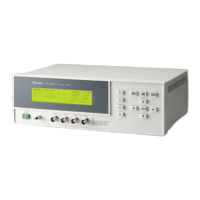
Do you have a question about the Chroma 11021 and is the answer not in the manual?
| Model | Chroma 11021 |
|---|---|
| Category | Measuring Instruments |
| Type | AC Power Source |
| Frequency Accuracy | 0.01% |
| Display | LCD |
| Harmonic Distortion | 0.5% |
| Interface | RS-232, GPIB |
| AC Test Signal Level | 20mV to 2.5V |
Disclaimers regarding manual content, company liability, and copyright.
Details the instrument's warranty period, coverage, and limitations.
Declaration of hazardous substances in the product, compliant with RoHS standards.
Confirms compliance with EMC and Low Voltage Directives using specific standards.
Instructions for proper storage, handling, cleaning, and disposal of the instrument.
Lists additions, deletions, and modifications for each manual revision.
Provides an overview of the LCR Meter and its applications.
Outlines primary measurement parameters, accuracy, range, frequency, and interface.
Provides comprehensive details on measurement functions, test signals, and parameters.
Details impedance, phase, resistance, and factor accuracy specifications.
Covers power requirements, operating environment, dimensions, and weight.
Instructions for proper installation, including ambient environment and power connection.
Covers fuse replacement, power regulation, and connecting the device under test (DUT).
Describes the front and rear panels, including displays, connectors, and controls.
Guides users on setting system parameters, modes, and memory management.
Details the process for performing Open and Short circuit corrections.
Explains how to set up BINNING and COMPARE functions for component testing.
Covers GPIB interface specifications, command structure, syntax, and detailed command sets.
Details the RS-232C interface, its specifications, connection, and commands.
Describes the handler interface pin assignments for BINNING and COMPARE functions.
Explains GPIB command structure, syntax rules, and transmission formats.
Details common, BINNing, CALCulate, [SENSe], SOURce, SYSTem, and TRIGger command sets.
Covers status reporting structure, registers, and error message management.